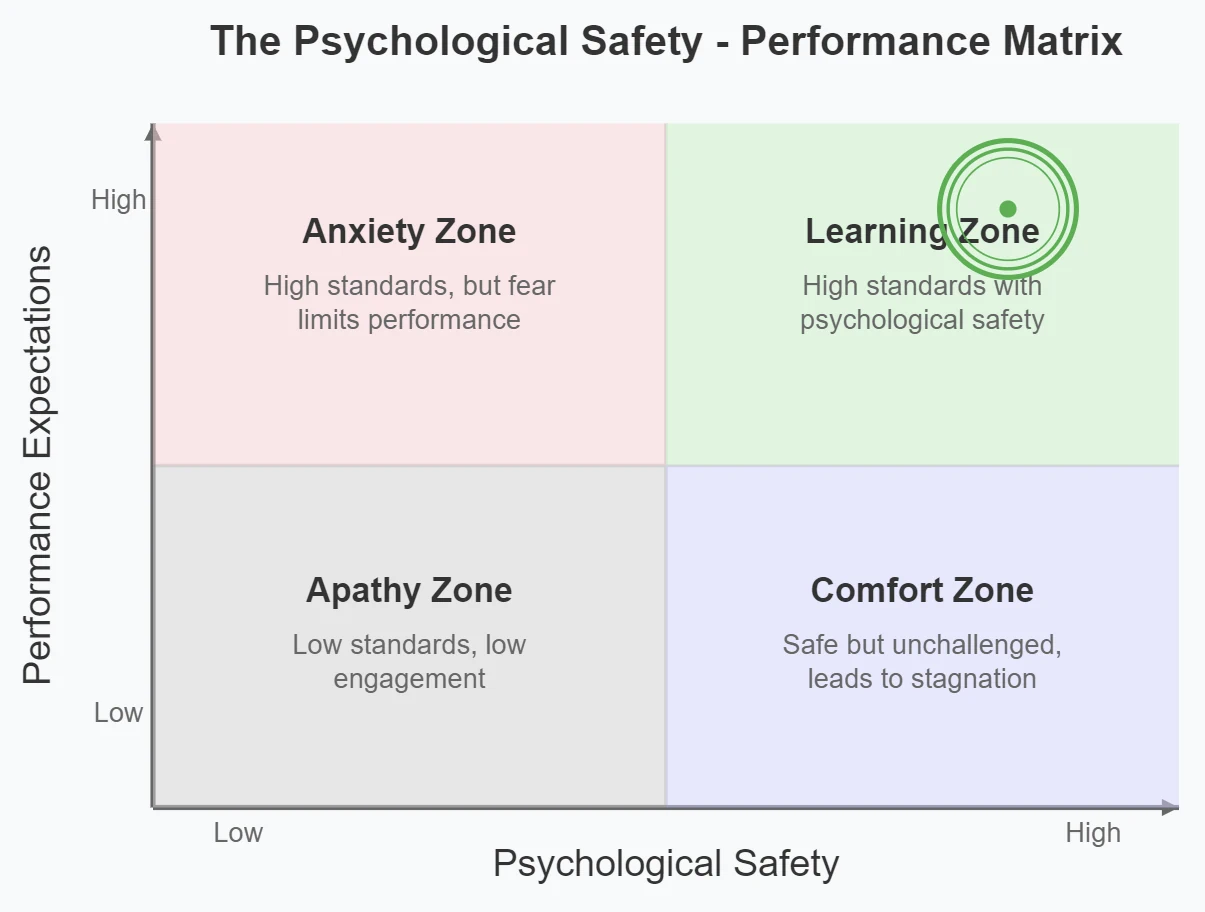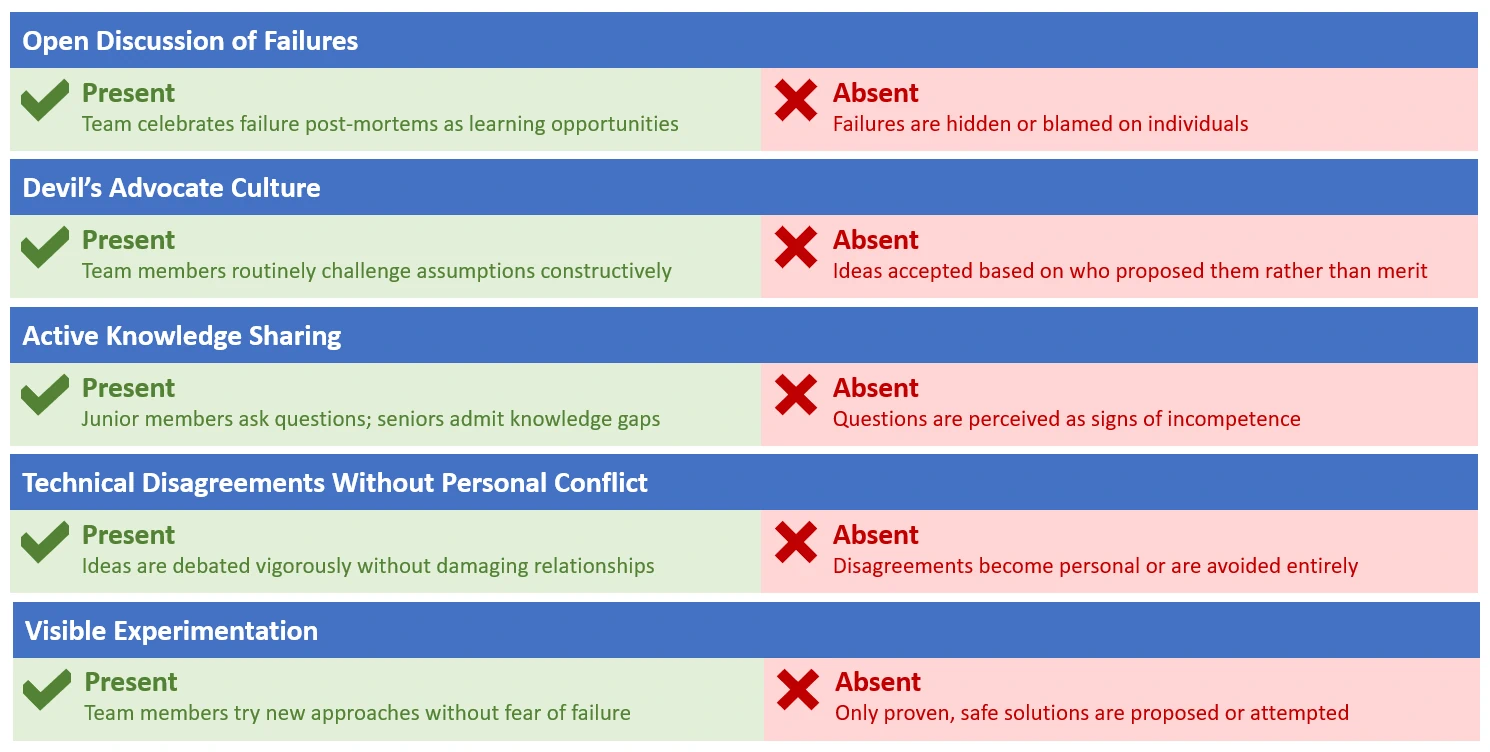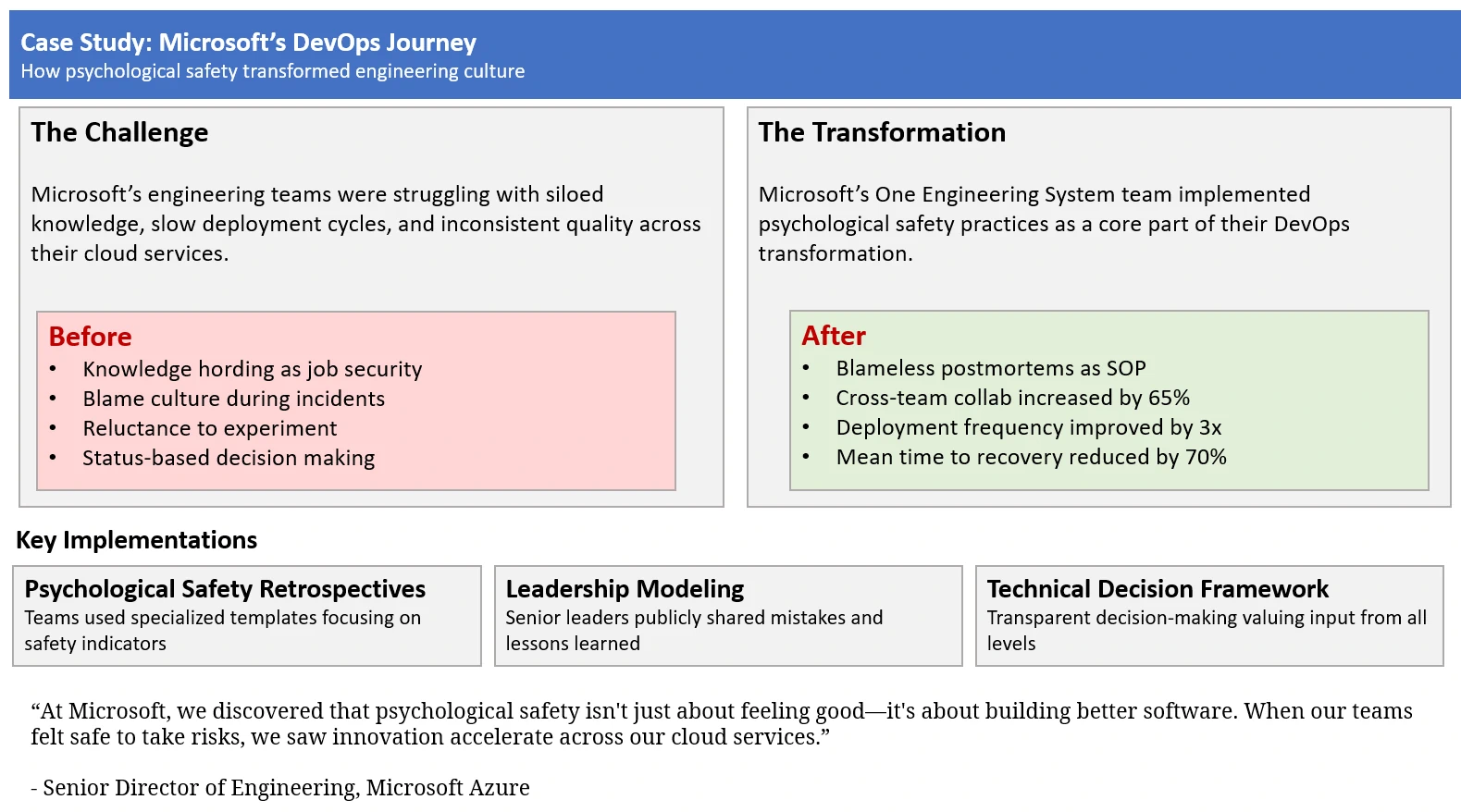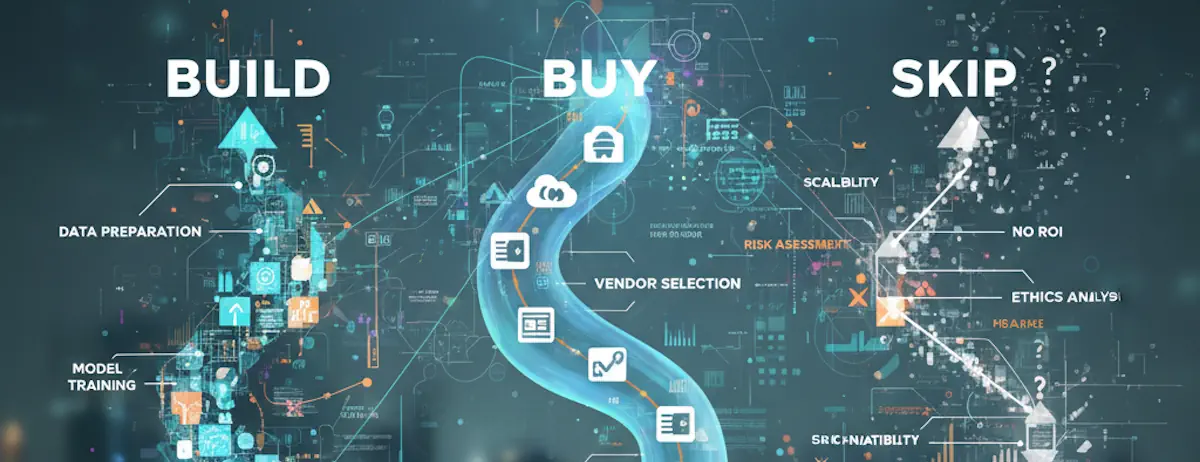Building Psychological Safety in High Performing Teams
Creating environments where innovation thrives and technical excellence is the byproduct of fearless collaboration.

I’ve spent the last two decades working with technical teams across various organizations—from startups to enterprises, from co-located to fully distributed. Throughout this journey, I’ve observed a consistent pattern: the highest-performing teams aren’t necessarily those with the most talented individuals, but rather those where team members feel safe to take risks, speak up, and be vulnerable.
This phenomenon—-psychological safety—-has transformed from academic concept to essential leadership practice, particularly in technical environments where innovation and complex problem-solving are paramount. As we navigate the ever-evolving workplace, understanding how to foster psychological safety has become more critical than ever for leaders.
The Paradox of High-Performance Teams
Product and technical organizations face a fascinating paradox. On one hand, they require precision, excellence, and reliability. On the other, they depend on creativity, experimentation, and the willingness to challenge existing paradigms. Without psychological safety, these competing demands create a paralyzing tension.
According to Google’s extensive Project Aristotle research, psychological safety emerged as the most critical factor in team effectiveness—more important than technical expertise, resource allocation, or even clear goals. Recent research continues to reinforce this finding, with the American Psychological Association’s 2024 Work in America report showing that workers experiencing high psychological safety report significantly better job performance and productivity than their peers (APA, 2024).
What makes these findings particularly relevant for technical teams is how they contradict the stereotypical image of the brilliant-but-difficult technical genius cranking out lines of code and thriving in isolation.
What Does Psychological Safety Look Like in Technical Teams?
Psychological safety manifests differently across teams and organizations. In technical environments, I’ve observed these distinct indicators:
- Open Discussion of Failures: Team members freely discuss mistakes and outages as learning opportunities rather than career-limiting events.
- Devil’s Advocate Culture: Engineers and product managers routinely challenge assumptions without fear of damaging relationships.
- Active Knowledge Sharing: Junior team members ask “obvious” questions, while senior staff readily admit knowledge gaps.
- Technical Disagreement Without Personal Conflict: Team members can have robust technical debates while maintaining mutual respect.
- Visible Experimentation: Failed experiments are celebrated for their learning value rather than hidden.
The most telling sign? When technical decisions are debated based on their merits rather than the seniority or influence of the person proposing them.
Indicators of Psychological Safety
The High Cost of Safety Deficits
The absence of psychological safety can be devastatingly expensive, particularly in technical organizations. A 2024 study published in the Empirical Software Engineering journal found that psychological safety directly impacts software quality by enabling key behaviors like knowledge sharing, open communication, and collaborative problem-solving (Springer, 2024). Additionally, recent DevOps research indicates that teams with low psychological safety show measurable declines in delivery throughput, recovery time, and change failure rates (Software.com, 2024).
In my experience, the costs manifest in distinct ways:
- Technical Debt Accumulation: When engineers fear reporting problems, technical debt compounds silently until major system failures occur.
- Narrow Solution Spaces: Teams explore fewer alternatives when members withhold creative but potentially “silly” ideas.
- Delayed Bug Detection: Issues discovered late in development cycles cost exponentially more to fix.
- Knowledge Silos: Expertise remains trapped with individuals rather than becoming team property.
- Reduced Operational Resilience: Teams struggle to respond effectively to incidents when members hesitate to communicate concerns or admit mistakes. Research from Polar Squad in 2024 indicates that companies fostering psychological safety show superior incident response and recovery times because team members freely voice concerns and admit knowledge gaps without fear (Polar Squad, 2024).
As one senior technical leader I was coaching once lameted: “Our biggest outage last year wasn’t caused by complexity. It happened because an engineer was too afraid to admit they didn’t understand a critical process.”
Building Psychological Safety in Technical Teams
Through trial and error, I’ve identified several approaches that effectively build psychological safety in technical environments:
1. Reframe Failure as Data Acquisition
Start treating failures—from small bugs to major incidents—as valuable data points rather than problems to be punished. Amazon’s approach to “one-way and two-way door decisions” provides an excellent framework: encourage experimentation when the consequences are reversible.
Implementation technique: Begin each sprint retrospective by having a senior leader share a recent mistake and what they learned. This normalizes the discussion of failure and sets the tone for others.
2. Create Structured Dissent Processes
Safety doesn’t emerge spontaneously—it requires deliberate structure, especially in technical discussions where strong opinions abound.
Implementation technique: Adopt formal mechanisms like Amazon’s “disagree and commit” principle or designate a rotating “red team” role in design reviews whose explicit job is to identify potential issues.
3. Establish Clear Technical Decision Frameworks
When teams understand how technical decisions will be evaluated, they’re more likely to contribute ideas without fear of arbitrary rejection.
Implementation technique: Create a decision matrix for architectural choices that explicitly weights different factors (performance, maintainability, timeline, etc.) and makes the evaluation process transparent.
4. Practice Inclusive Technical Communication
Technical discussions can inadvertently exclude team members when they rely on implicit knowledge or specialized vocabulary.
Implementation technique: Establish team norms that encourage asking for clarification and avoiding acronyms without explanation. Create a team glossary for specialized terms and update it continuously.
5. Measure and Monitor Psychological Safety
What gets measured gets managed. While psychological safety can seem intangible, it can and should be tracked.
Implementation technique: Conduct anonymous pulse surveys with questions specifically designed to assess psychological safety in technical contexts:
- “How confident are you that you could raise a concern about a technical approach without negative consequences?”
- “In the last sprint, did you hold back a technical opinion because you feared how others might respond?”
- “If you discovered a significant bug in code written by a senior team member, how comfortable would you feel pointing it out?”
Balancing Safety with Accountability
One common misconception is that psychological safety means lowering standards or avoiding accountability. In fact, research shows the opposite: teams with high psychological safety can maintain higher standards because feedback flows freely.
Recent research published in Harvard Business Review in January 2024 explored the question “Can Workplaces Have Too Much Psychological Safety?” The conclusion was clear: psychological safety works best when paired with high performance expectations (HBR, 2024). The key is understanding that accountability without safety creates fear, while safety without accountability creates complacency. The sweet spot combines high psychological safety with high performance expectations.
In practice, this means:
- Separating performance feedback from personal worth
- Evaluating decisions based on the information available at the time, not just outcomes
- Maintaining clear technical standards while being flexible about the path to meet them
- Recognizing effort and approach even when results fall short
Case Study: Microsoft’s DevOps Transformation
Microsoft’s journey toward psychological safety within their DevOps teams offers valuable insights for organizations seeking to improve their own technical culture.
Before their transformation, Microsoft’s engineering teams faced challenges typical of many large technical organizations: siloed knowledge, blame culture during incidents, and status-based decision making. Their transformation began when the One Engineering System team recognized that their cultural issues were undermining their technical excellence.
By implementing specialized retrospective templates, encouraging leadership vulnerability, and creating transparent technical decision frameworks, Microsoft saw measurable improvements:
- Deployment frequency improved by 3x
- Mean time to recovery reduced by 70%
- Cross-team collaboration increased by 65%
As a Senior Director of Engineering at Microsoft Azure noted, “At Microsoft, we discovered that psychological safety isn’t just about feeling good—it’s about building better software. When our teams felt safe to take risks, we saw innovation accelerate across our cloud services.”
Getting Started: Monday Morning Actions
If you’re looking to enhance psychological safety on your technical team, here are three concrete actions you can take immediately:
Conduct a Safety Audit: In your next one-on-one meetings, ask team members: “What’s the smallest thing that would make you feel safer contributing ideas?” The patterns in these responses will reveal your most important opportunities.
Model Vulnerability: In your next technical discussion, openly acknowledge something you don’t understand or a mistake you made recently. The vulnerability of leaders sets the upper limit for team psychological safety.
Revisit a Recent Failure: Choose a recent technical challenge or failure and facilitate a blameless review focused entirely on systemic factors and learning opportunities.
Conclusion: The Competitive Advantage of Psychological Safety
In today’s technical landscape, where complexity is increasing and change is constant, psychological safety isn’t just a cultural nicety—it’s a strategic advantage. Teams that can harness the full cognitive capacity and diverse perspectives of all members will inevitably outperform those where fear limits contribution.
Recent research from The Digital Project Manager found that teams with high psychological safety are twice as likely to be rated as highly innovative by peers and supervisors, and team members in psychologically safe environments are 76% more engaged than those who don’t feel safe speaking up (The Digital Project Manager, 2024).
The most successful technical organizations I’ve worked with don’t view psychological safety as a separate initiative from technical excellence—they recognize it as the foundation that makes technical excellence possible. As DevOps approaches continue to transform the technical landscape in 2024 and beyond, organizations that excel at creating psychologically safe environments will have the edge in attracting talent, driving innovation, and delivering exceptional results.
What’s your experience with psychological safety in technical environments? I’d love to hear your thoughts and approaches in the comments below.











